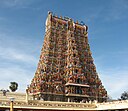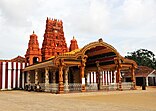Tamil culture
Tamil culture is the
History
Historically, the
Language
Tamil people speak Tamil, which is one of the oldest languages and was the first to be recognized as a
Literature
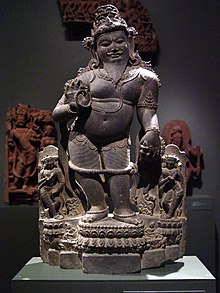
In the beginning of the
In 1578, the Portuguese published a Tamil book in old Tamil script named 'Thambiraan Vanakkam', thus making Tamil the first Indian language to be printed and published.
Art and architecture
According to Sangam literature, there are 64 artforms called aayakalaigal.[36] The art is classified into two broad categories: kavin kalaigal (beautiful art forms) which include architecture, sculpture, painting and poetry and nun kalaigal (fine art forms) which include dance, music and drama.[37]
Architecture
There are a number of rock-cut cave-temples established by the ancient Tamil kings and later by Pandyas and Pallavas.[38] The Group of Monuments at Mahabalipuram, built by the Pallavas in the 7th and 8th centuries has more than forty rock-cut temples and monoliths including one of the largest open-air rock reliefs in the world.[39][40]

With the
Painting and sculpture
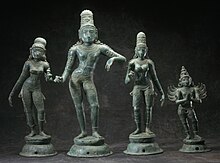
Most visual arts are religious in some form and usually centers on
Music
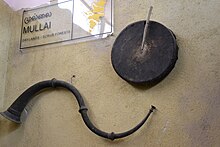
The ancient Tamil country had its own
Dance

Bharatanatyam is a major genre of Indian classical dance that originated in Tamilakam.[77][78] It is one of the oldest classical dance forms of India.[77][79] The dancer is usually dressed in a colorful silk sari with various jewelry and anklets called salangai, made up of small bells.[80] All dancers[81][82] The dance is characterized by the fixed upper torso with bent legs or flexed out knees combined with various footwork and a number of gestures known as abhinaya using various hand mudras, expressions using the eyes and other face muscles.[83]

There are many folk dance forms that originated and are practiced in the region. Karakattam involves dancers balancing clay or metal pot(s) on the head while making movements with the body.[84][85] Kavadiattam is a ceremonial act of sacrifice, wherein the dances bear a kavadi, a wooden stick balanced on the shoulders with weights on both the ends.[86][87] Kolattam is usually performed by women in which two small sticks (kols), one in each hand are crisscrossed to make specific rhythms while singing songs.[88][89] Kummi is similar to Kolattam, with the difference being that hands are used to make sounds while dancing instead of sticks used in the later.[90][91] In Mayilattam, dancers dressed as peacocks with peacock feathers, glittering head-dresses and beak perform to various folk songs and tunes.[92][93]
Performance arts

Koothu is a form of street theater that consists of a play performance which consists of dance along with music, narration and singing.[105] The performers wear elaborate wooden headgear, special costumes with swirling skirts, ornaments such as heavy anklets along with prominent face painting and make-up.[106] The art is performed during festivals in open public places and is usually dedicated to goddesses such as Mariamman or Draupadi with stories drawn from Hindu epics such as Ramayana and Mahabharata, mythology and folklore.[106]such as temples or village squares.[106] The dance is accompanied by music played from traditional instruments and a kattiyakaran narrates the story during the performance.[106]
Martial arts
Tamil martial arts uses various types of weapons such as
Modern arts
Tamil Nadu is also home to the Tamil film industry nicknamed as Kollywood" and is one of the largest industries of film production in India.[121][122] The term "Kollywood" is a blend of Kodambakkam and Hollywood.[123] Samikannu Vincent, who had built the first cinema of South India in Coimbatore, introduced the concept of "Tent Cinema" in the early 1900s, in which a tent was erected on a stretch of open land close to a town or village to screen the films. The first of its kind was established in Madras, called "Edison's Grand Cinemamegaphone".[124][125][126] The first silent film in South India was produced in Tamil in 1916 and the first talkie was a multi-lingual film, Kalidas, which released on 31 October 1931, barely seven months after India's first talking picture Alam Ara.[127][128]
Clothing

Tamil women traditionally wear a
A colourful
Cuisine

Festivals

Pongal is a major and multi-day harvest festival celebrated by Tamils.[148] It is observed in the month of Thai according to the Tamil solar calendar and usually falls on 14 or 15 January.[149] It is dedicated to the Surya, the Sun God and the festival is named after the ceremonial "Pongal", which means "to boil, overflow" and refers to the traditional dish prepared from the new harvest of rice boiled in milk with jaggery offered to Surya.[150][151][152] Mattu Pongal is meant for celebration of cattle when the cattle are bathed, their horns polished and painted in bright colors, garlands of flowers placed around their necks and processions.[153] Jallikattu is a traditional event held during the period attracting huge crowds in which a bull is released into a crowd of people, and multiple human participants attempt to grab the large hump on the bull's back with both arms and hang on to it while the bull attempts to escape.[154]

Religion
As per the sangam era works, the
In Tamil tradition, Murugan is the youngest son of Shiva and
The Christian apostle,
As of the 21st century, majority of the Tamils are adherents of Hinduism.[182] Atheist, rationalist, and humanist philosophies are also adhered by sizeable minorities, as a result of Tamil cultural revivalism in the 20th century, and its antipathy to what it saw as Brahminical Hinduism.[183]
- Places of Worship
There are more than 34,000 temples in Tamil Nadu built across various periods some of which are several centuries old.
Reference
- ^ "The Washington Post : Very old, very sophisticated tools found in India. The question is: Who made them?". The Washington Post. Archived from the original on 10 February 2018. Retrieved 9 February 2018.
- ^ "Skeletons dating back 3,800 years throw light on evolution". The Times of India. 1 January 2006. Retrieved 11 June 2008.
- ^ "A rare inscription". The Hindu. 1 July 2005. Retrieved 11 June 2008.
- ^ "Three Crowned Kings of Tamilakam". National Geographic Society. Retrieved 1 December 2023.
- ^ "Danish flavour". The Hindu. 6 November 2009. Retrieved 5 August 2013.
- OCLC 4202160.
- Britannica. Retrieved 1 December 2023.
- . Retrieved 4 November 2022.
- ^ "Several dialects of Tamil". Inkl. 31 October 2023. Retrieved 1 December 2023.
- ^ a b Ramasamy, Sumathi. "3". Passions of the Tongue: Language Devotion in Tamil India, 1891-1970. University of California. p. 79-134.
- ISBN 978-0-521-77111-5.
- ISBN 978-0-415-33323-8.
- JSTOR 3516775.
- ^ "Five fold grammar of Tamil". University of Pennsylvania. Archived from the original on 9 June 2007. Retrieved 8 October 2015.
- ^ Subramaniam, T.S. (29 August 2011). "Palani excavation triggers fresh debate". The Hindu. Chennai, India. Retrieved 1 December 2023.
- S2CID 162291987.
- ISBN 978-81-208-1215-4.
- (PDF) from the original on 3 September 2019. Retrieved 6 September 2019.
- ISBN 978-0-674-97465-4.
- ^ "Five fold grammar of Tamil". University of Pennsylvania. Archived from the original on 9 June 2007. Retrieved 8 October 2015.
- ISBN 90-04-10042-3.
- ISBN 90-04-09365-6.
- ^ T.V. Mahalingam (1981). Proceedings of the Second Annual Conference. South Indian History Congress. pp. 28–34.
- ^ S. Sundararajan. Ancient Tamil Country: Its Social and Economic Structure. Navrang, 1991. p. 233.
- ISBN 978-8-120-60955-6.
- ^ ISBN 978-1-000-78039-0.
- ISBN 978-81-7017-398-4.
- ISBN 978-1-350-03925-4.
- ISBN 978-9-351-18100-2.
- ISBN 978-9-380-60721-4.
- ^ Karthik Madhavan (21 June 2010). "Tamil saw its first book in 1578". The Hindu. Archived from the original on 1 January 2016. Retrieved 8 October 2015.
- ^ Kolappan, B. (22 June 2014). "Delay, howlers in Tamil Lexicon embarrass scholars". The Hindu. Chennai. Archived from the original on 4 July 2014. Retrieved 25 December 2014.
- ISBN 978-0-195-12813-0.
- ^ Arooran, K. Nambi (1980). Tamil Renaissance and the Dravidian Movement, 1905-1944. Koodal.
- ISSN 1305-578X. Retrieved 1 December 2023.
- ^ Cuppiramaṇiyan̲, Ca. Vē (1983). Heritage of the Tamils:Siddha Medicine. International Institute of Tamil Studies. p. 554.
- ISBN 978-8-184-58006-8.
- ^ Dayalan, D. (2014). Cave-temples in the Regions of the Pāṇdya, Muttaraiya, Atiyamān̤ and Āy Dynasties in Tamil Nadu and Kerala. Archaeological Survey of India.
- ISBN 978-0-8239-3179-8.
- ISBN 978-1-4262-0336-7.
- ^ ISBN 978-8-1208-0810-2.
- ^ Fergusson, James (1997) [1910]. History of Indian and Eastern Architecture (3rd ed.). New Delhi: Low Price Publications. p. 309.
- ISBN 978-0-4712-6892-5.
- ISBN 978-0-4712-8451-2.
- ^ "Group of Monuments at Mahabalipuram". UNESCO World Heritage Centre. Archived from the original on 2 December 2019. Retrieved 3 April 2022.
- ISBN 978-0-2265-3230-1.
- ^ "Gopuram". Encyclopædia Britannica. Retrieved 20 January 2008.
- Times of India. 7 November 2016. Retrieved 20 January 2018.
- ISBN 978-9-0602-3607-9
- ISSN 2321-788X. Retrieved 5 July 2019.
- ^ Metcalfe, Thomas R. "A Tradition Created: Indo-Saracenic Architecture under the Raj". History Today. 32 (9). Retrieved 28 December 2012.
- ^ "Indo-saracenic Architecture". Henry Irwin, Architect in India, 1841–1922. higman.de. Archived from the original on 30 July 2020. Retrieved 28 December 2012.
- ^ "Art Deco Style Remains, But Elements Missing". The New Indian Express. 2 September 2014. Retrieved 28 December 2022.
- ^ "Chennai looks to the skies". The Hindu. Chennai. 31 October 2014. Retrieved 28 December 2022.
- ^ "Krishna Rajamannar with His Wives, Rukmini and Satyabhama, and His Mount, Garuda | LACMA Collections". collections.lacma.org. Archived from the original on 16 July 2014. Retrieved 23 September 2014.
- ISBN 978-1-933-31634-5.
- ^ Ganapathi, V. "Shilpaic literature of the tamils". INTAMM. Retrieved 4 December 2006.
- S2CID 192943206.
The bronze icons of the Early Chola period are one of India's greatest contributions to world art...
- ISBN 978-8-170-17376-2.
- ^ Sudharsanam. A centre for Arts and Culture (PDF). Indian Heritage Organization. Retrieved 26 October 2012.
- ^ "Sittanavasal – A passage to the Indian History and Monuments". Puratattva. 2 May 2011. Retrieved 26 October 2012.
- ^ "The Ajanta of TamilNadu". The Tribune. 27 November 2005. Retrieved 1 December 2023.
- ISBN 81-904055-1-9.
- ISBN 978-8-170-17127-0.
- ISBN 978-9-004-03978-0.
- ^ Widdess, D. R. (1979). "The Kudumiyamalai inscription: a source of early Indian music in notation". In Picken, Laurence (ed.). Musica Asiatica. Vol. 2. London: Oxford University Press. pp. 115–150.
- ISBN 978-8-125-01619-9.
- ISBN 978-0-199-35171-8.
- ISBN 978-1-3045-0409-8.
- ^ Indian Express. 26 July 2022. Retrieved 1 December 2023.
- Britannica. Retrieved 1 March 2023.
- ^ G, Ezekiel Majello (10 October 2019). "Torching prejudice through gumption and Gaana". Deccan Chronicle. Archived from the original on 6 December 2020. Retrieved 12 May 2020.
- ^ Alastair Dick (1984). Sadie, Stanley (ed.). Villādivādyam. Vol. 3. The New Grove Dictionary of Musical Instruments. p. 727.
- ISBN 978-81-8094-432-1.
- Indian Express. 5 December 2018. Retrieved 1 December 2023.
- ISBN 978-0-8195-6906-6.
- ^ a b "Bharata-natyam". Britannica. Retrieved 1 December 2023.
- ^ Banerjee, Projesh (1983). Indian Ballet Dancing. New Jersey: Abhinav Publications. p. 43.
- ISBN 978-0-812-27929-0.
- ISBN 978-0-8195-6837-3.
- ISBN 978-81-7023-494-4.
- ISBN 978-81-246-0215-7.
- ISBN 978-0-8239-3179-8.
- ISBN 978-9-004-09467-3.
- ISBN 978-0-253-35528-7.
- ISBN 978-8-791-11489-2.
- ISBN 978-1-000-18987-2.
- ISBN 978-8-124-11337-0.
- ISBN 978-1-618-13360-1.
- ^ Raghavan, M. D. (1971). Tamil Culture in Ceylon: A General Introduction. Kalai Nilayam. p. 174.
- ^ Mahalingam, T. V. (1990). South Indian Studies. Geetha Books. p. 990.
- ISBN 978-90-420-2799-2.
- ISBN 978-1-721-03274-7.
- ISBN 978-0-195-69084-2.
- ^ "Folk dances". Seminar: The Monthly Symposium. Romeshraj Trust: 35. 1993.
- ^ "Oyilattam". Government of Tamil Nadu, South Zone Cultural Center. Retrieved 3 August 2009.
- ISBN 978-1-638-86554-4.
- ^ "Folk dances of South India". Cultural India. Retrieved 1 December 2023.
- ISBN 978-9-352-01769-0.
..Thaarai and thappattai, native instruments of Tamil people..
- ISBN 978-0-199-35171-8.
- ISBN 978-1-4422-5749-8.
- ^ Sangeet Natak. Sangeet Natak Akademi. 1981. p. 35.
- ISBN 978-8-185-12022-5.
- ISBN 978-1-596-82117-0.
- ISBN 978-1-136-70392-8.
- ^ ISBN 978-8-186-21147-2.
- ISBN 978-0-195-69917-3.
- ^ ISBN 978-0-521-58822-5.
- ISBN 978-1-317-27886-3.
- ^ "Chennai Sangamam to return after a decade". The Times of India. 30 December 2022. Retrieved 1 December 2023.
- ^ "Martial Arts (Silambam & Kalaripayattu)". Government of India. Retrieved 27 November 2020.
- ISSN 0971-751X. Retrieved 11 February 2023.
- ^ Sarkar, John (17 February 2008). "Dravidian martial art on a comeback mode". The Economic Times. Retrieved 5 December 2020.
- ISBN 978-1-409-22626-0.
- ^ Zarrilli, Phillip B. (1992). "To Heal and/or To Harm: The Vital Spots (Marmmam/Varmam) in Two South Indian Martial Traditions Part I: Focus on Kerala's Kalarippayattu". Journal of Asian Martial Arts. 1 (1).
- ISSN 0094-0496.
- ISBN 978-9-350-94484-4.
- ISBN 978-1-546-23979-6.
- ISBN 978-1-5381-0686-0.
- ISBN 978-0-415-93919-5.
- ^ "Tamil Nadu leads in film production". The Times of India. 22 August 2013. Archived from the original on 16 November 2014. Retrieved 25 March 2015.
- ^ Bureau, Our Regional (25 January 2006). "Tamil, Telugu film industries outshine Bollywood". Business Standard. Archived from the original on 25 March 2021. Retrieved 19 February 2012.
- ISBN 978-1-56858-427-0. Archivedfrom the original on 22 August 2023. Retrieved 20 October 2020.
- ^ "A way of life". Frontline. 18 October 2013. Retrieved 19 June 2018.
- ^ "Cinema and the city". The Hindu. 9 January 2009. Retrieved 1 March 2023.
- Times of India. 9 May 2011. Retrieved 19 June 2018.
- ISBN 978-0-415-39680-6. Archivedfrom the original on 22 August 2023. Retrieved 20 October 2020.
- ^ "From silent films to the digital era — Madras' tryst with cinema". The Hindu. 30 August 2020. Retrieved 29 June 2021.
- ISBN 0-9661496-1-0.
- ISBN 978-0-8109-4461-9.
- ISBN 978-0-2310-7849-8.
- ISBN 978-0-1302-5380-4.
- ^ "About Dhoti". Britannica. Retrieved 12 January 2016.
- ^ a b "Clothing in India". Britannica. Retrieved 12 January 2016.
- ^ "Weaving through the threads". The Hindu. Retrieved 7 March 2015.
- ^ a b Geographical indications of India (PDF) (Report). Government of India. Retrieved 28 June 2023.
- ^ "31 ethnic Indian products given". Financial Express. Retrieved 28 June 2015.
- FAO. Retrieved 17 August 2012.
- ISBN 978-1-8618-9426-7.
- ISBN 978-0-5202-3674-5.
- ISBN 978-9-7191-7513-1.
- ISBN 978-0-7787-9287-1.
- ^ "Serving on a banana leaf". ISCKON. Retrieved 1 January 2023.
- ^ "The Benefits of Eating Food on Banana Leaves". India Times. 9 March 2015. Retrieved 20 March 2016.
- ISBN 978-8-1737-1293-7.
- ISBN 978-1-350-12864-4.
- ISBN 979-8-508-82055-8.
- ISBN 978-0-7007-1267-0. Archivedfrom the original on 21 April 2023. Retrieved 30 October 2019.
- JSTOR 2797924.
- ISBN 978-93-80325-91-0. Archivedfrom the original on 21 April 2023. Retrieved 30 October 2019.
- ISBN 978-1-59884-206-7.
- ISBN 978-0-930741-98-3. Archivedfrom the original on 21 April 2023. Retrieved 30 October 2019.
- JSTOR 25841633.
- ^ Ramakrishnan, T. (26 February 2017). "Governor clears ordinance on 'jallikattu'". The Hindu. Retrieved 1 December 2023.
- ISBN 978-1-4042-3808-4.
- ISBN 978-0-14-341421-6.
- ISBN 978-1-56308-576-5.
- ISBN 978-81-8205-061-7.
- ISBN 978-8-7911-1489-2.
- ISBN 978-1-0001-8987-2.
- ISBN 978-0-780-81365-6.
- ^ Chandramouli, C. (2004). Arts and Crafts of Tamil Nadu. Directorate of Census Operations. p. 74.
- ISBN 978-81-208-3816-1.
- ISBN 978-81-7017-398-4.
- ISBN 978-3-11-080410-2.
- ^ Mahadevan, Iravatham (2006). A Note on the Muruku Sign of the Indus Script in light of the Mayiladuthurai Stone Axe Discovery. Harappa. Archived from the original on 4 September 2006.
- ^ Steven Rosen, Graham M. Schweig (2006). Essential Hinduism. Greenwood Publishing Group. p. 45.
- ^ Nagarajan, Saraswathy (17 November 2011). "On the southern tip of India, a village steeped in the past". The Hindu. Retrieved 23 March 2017.
- ^ Subramanian, T. S. (24 March 2012). "2,200-year-old Tamil-Brahmi inscription found on Samanamalai". The Hindu. Retrieved 19 January 2014.
- ISBN 978-0-4153-2920-0. Retrieved 7 September 2016.
- ISBN 978-0-6700-8478-4.
- ^ Rao, S.R. (1991). "Marine archaeological explorations of Tranquebar-Poompuhar region on Tamil Nadu coast" (PDF). Journal of Marine Archaeology. 2: 6.
- ^ Duraiswamy, Dayalan. Role of Archaeology on Maritime Buddhism.
- ISBN 978-0-19-560686-7.
- ^ Tamil Civilization:Quarterly Research Journal of the Tamil University. Vol. 5. University of Michigan. 1987. p. 9.
- ^ ISBN 978-1-457-99010-6.
- ^ "Principles and Practice of Hindu Religion". Hindu Heritage Study Program. Archived from the original on 14 November 2006. Retrieved 5 December 2006.
- .
- ^ "Santhome Cathedral". Government of Tamil Nadu. Retrieved 28 December 2022.
- ISBN 0-7007-1130-9.
- ISBN 978-81-250-2632-7.
- ^ Census 2001 – Statewise population by Religion (Report). Censusindia.gov.in. Retrieved 18 July 2010.
- .
- ^ "Tamil Nadu, Andhra Pradesh build temple ties to boost tourism". The Times of India. 10 August 2010. Retrieved 1 December 2023.
- PMID 22556587.
- ^ "A comprehensive description of the 276 Shivastalams glorified by the Tevaram hymns". Templenet. Retrieved 11 January 2011.
- ISBN 978-0-470-82958-5.
- ISBN 978-0-4708-2958-5.
- Britannica. Retrieved 1 December 2023.
- Britannica. Retrieved 1 December 2023.
- ^ "Sri Ranganathaswamy Temple, Srirangam". UNESCO. Retrieved 1 December 2023.
- Britannica. Retrieved 1 December 2023.
- ^ "Namakkal Anjaneyar Temple". Government of Tamil Nadu. Retrieved 1 December 2023.
- ^ "Eachanari Vinayagar temple". Government of Tamil Nadu. Retrieved 1 December 2023.
- ^ "Ucchi Pillayar Temple, Rockfort". Government of Tamil Nadu. Retrieved 1 December 2023.
- ^ "Amman temples". Government of Tamil Nadu. Retrieved 1 December 2023.
- Britannica. Retrieved 1 December 2023.
- ISBN 979-8-2161-5549-2.
- ^ Pathmanathan, S (September 1999). "The guardian deities of Sri Lanka: Skanda-Murgan and Kataragama". The Journal of the Institute of Asian Studies. The institute of Asian studies. Archived from the original on 26 September 2010.
- ^ Bechert, Heinz (1970). "Skandakumara and Kataragama: An Aspect of the Relation of Hinduism and Buddhism in Sri Lanka". Proceedings of the Third International Tamil Conference Seminar. Paris: International Association of Tamil Research. Archived from the original on 25 September 2010.
- ^ Star, The. "Tallest statue of deity unveiled". Archived from the original on 15 August 2018. Retrieved 15 August 2018.
- ^ "Batu Caves". Britannica. Archived from the original on 15 August 2018. Retrieved 15 August 2018.
- ^ "Erwadi santhanakoodu festival". Government of India. Retrieved 1 December 2023.
- ISBN 978-1-4614-0447-7.
- ^ "Velankanni". Government of Tamil Nadu. Retrieved 1 December 2023.
- ^ Jain, Mahima A. (February 2016). "Looking for Jina Kanchi". The Hindu.
- ^ "Chitharal". Tamil Nadu Tourism. Retrieved 23 March 2017.
- ^ "Arihantagiri – Tirumalai". Jain Heritage centres. Retrieved 29 December 2022.
- ISBN 978-8-126-13259-1.

